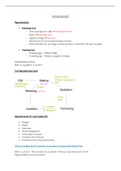Neonatal growth
Pig production
• Breeding herd
– Sows (young sow = gilt) ➔ breeding female
– Boars ➔breeding male
– Piglets to 30kg ➔ Neonate
– Replacements (incoming breeding animals)
– When females are no longer producing litters, send them off, get new gilts
• Feeding herd
– Growing pigs – 30kg to 50kg
– Finishing pigs – 50kg to slaughter (110kg)
CONTINUOUS CYCLE
Birth to slaughter- 6 months
The Reproductive Cycle
Requirements for mammalian life
• Oxygen
• Water
• Nutrients
• Thermoregulation
• Elimination of waste
• Freedom from disease
• Protection from the environment
All are provided by the uterine environment and placental blood flow
Birth is a shock - The neonate has to obtain all these requirements for itself
Piglet spelled into environment
,Wet, little hair
Small, large SA: volume body ratio
Limited energy reserves- enough to sustain life for 16 hours
Get up and find teat to gain energy
High mortality rate- first 3 days- don’t get to teed- starve to death or sow crushing
Larger litter size- decrease size of piglets
Thermal imaging
Piglets loose surface body temperature
Newborn= 38.4 C
30 mins= 29.8 C
45+ mins= 24.4 C
Relationship between body weight of an animal and vasomotor index
Takes into account sex, metabolic rate, area, size of animal
How well an animal can prevent heat loss
Small animals- not good
Piglets shiver- warm up (muscles contracting- need to be able to do this, use energy)
What is colostrum?
• Colostrum is defined as the mammary secreta being ingested by piglets from birth of
1st born piglet and until 24 hour later
• High energy – lactose and fat
• High protein as immunoglobulins
• Growth factors
• Biosynthesised by sow in late gestation
Colostrum/milk composition
,Low dry matter
Majority is water
CP high due to immunoglobulins
Passive immunity
• Piglets don’t have any circulating antibodies in blood when born
• No transfer of immunoglobins via the placenta
• Provided by maternal immunoglobulins which are absorbed intact across the ‘open’
SI.
• Cessation (‘gut closure’) is complete by 36-48 hours after birth.
– This is associated by a decrease in total immunoglobulin concentration in milk.
Immunoglobulins
Family of proteins with a range of bioactivities
Heavy and light chains- linked by disulphide bonds- y shape immunoglobulin
• Divided into several classes including:
• IgG, IgM, IgA
IgG- systemic protection
IgM- intestinal lignan
IgA- prevent pathogenic invasion of bacteria across the gut
Immunoglobulins
• Immunoglobulins are transferred mainly to the foetus via the placenta (humans and
rabbits)
• Born agammaglobulinemic therefore immunoglobulin transmission occurs via
mammary secretions (horses, pigs, cows)
– Immature immune system when born
– Mothers milk
– Transfer of passive immunity
– Immature immune system
• Immunoglobulins are transferred vis placenta and mammary secretions (rats, mice,
dogs)
, ~Differences due to differences in the structure of the placenta in these animals
Placenta - morphological variation
• Epitheliochorial placentation (swine and horses) retains all six maternal and foetal
tissue layers – maternal endothelium, maternal connective tissue, maternal (uterine)
epithelium, foetal (chorionic) epithelium, foetal connective tissue, and foetal
endothelium.
• Syndesmochorial placentation (ruminants) consists of five tissue layers, i.e., maternal
endothelium, maternal connective tissue, chorionic epithelium, foetal connective
tissue, and foetal endothelium. Thus, the maternal (uterine) epithelium is absent.
• Endotheliochorial placentation (most carnivores) separates maternal and foetal blood
circulation by four tissue layers including maternal endothelium, chorionic epithelium,
foetal connective tissue, and foetal endothelium. Thus, the chorionic epithelium of
the foetus is in direct contact with the endothelium of the maternal capillaries.
• Hemochorial placentation (human and rabbits) is composed of three tissue layers
(chorionic epithelium, foetal connective tissue, and foetal endothelium). This brings
the maternal blood circulation into direct contact with the chorionic epithelium.
Leiser and Kaufmann 1994
Placental level of invasiveness




